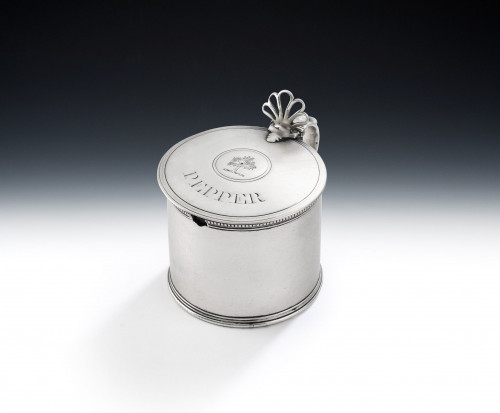A magnificent & important George III tWO Two handled Tray, of large size, from the Townley-Parker Dinner Service. Made in London in 1816 by Paul Storr.
A magnificent & important George III tWO Two handled Tray, of large size, from the Townley-Parker Dinner Service. Made in London in 1816 by Paul Storr.
375299
This magnificent Tray is of a large size and stands on four large scroll and Rococo shell feet flanked by acanthus foliage and fruiting vines. The main body has a shaped oval form, with raised border decorated with reed and trailing vine designs, interspersed with baskets of grapes and stylised fleur-de-lys motifs. The raised, naturalistic, branch handles are attached to the main body with finely detailed oak leaf and acorn mouldings. The decoration on the handles, border and feet is in exceptional condition. The centre is beautifully engraved with a contemporary Armorial, with Crest above and the motto "Sapere Aude - Dare to be wise" below, all surrounded by a cartouche of drapery mantling and tassels.
The Tray is in excellent condition and is well marked on the underside. It is of a magnificent size and weight. The silver is also engraved with the pattern number 865. This piece was part of a unique design silver dinner service, the decorative border almost certainly designed by Lewis Wyatt, which was supplied to Robert Townley-Parker in 1816 on the occasion of his marriage to Harriet Brooke on 21st December, 1816.
Height, to the top of the handles: 4 inches, 10 cm.
Total Length: 27.25 inches, 68.13 cm.
Width: 19 inches, 47.5 cm.
Weight: 184 oz.
PRICE £ 45,000,
ARMORIAL
The Arms are those of Parker quartering Townley and impaling Brooke for Robert Townley-Parker (1793-1879) of Cuerden Hall Preston, who married Harriet, daughter of Thomas Brooke of Church Minshall, Cheshire in 1816.
PROVENANCE
Supplied to Robert Townley-Parker (1793-1879) and Harriet Brooke of Cuerden Hall in 1816 on the occasion of their marriage and by descent to their eldest son.
Thomas Townley-Parker (d1906) and thence by descent to his nephew
Reginald Arthur Tatton and by descent to
Captain T.A. Tatton M.C.
Captain T.A. Tatton, removed from Cuerden Hall, Preston, and sold at Christie’s London 12, December 1928.
ADDITIONAL INFORMATION
Robert Townley-Parker served as M.P. for Preston, Lancashire, 1837-1857, and was High Sheriff of the County in 1817. In 1816, he married Harriet, youngest daughter of Thomas Brooke of Minshall Cheshire. Upon his death in 1879, the illustrated London News described Townley-Parker as “One of the chief proprietors among the landed gentry in the county of Lancaster”. He was succeeded by his eldest son, Thomas. On his death in 1906 the manors, land and chattels passed to his nephew Mr Reginald Arthur Tatton of Chelford, in Cheshire.
Cuerden Hall, Lancashire, descended from the Cuerdens and Banasters to the Townley-Parker family, and was re-modelled by Robert Townley-Parker in 1816-19. Together with its landscaped park, Cuerden Hall was a significant contribution to the nineteenth-century Picturesque movement (J.M. Robinson, A Guide to the Country Houses of the North West, 1991, PP. 176-177).
Other pieces from this extensive silver dinner service supplied to celebrate the marriage of Robert Townley-Parker and Harriet Brookes include a toasted cheese dish (M.A. Moss, the Lillian and Morrie Moss Collection of Paul Storr Silver, Miami, 1972, P.262, NO 196) and a Meat Dish (Partridge, Christie’s New York, 17th May 2006, lot 143), each with the same distinctive border.
PAUL STORR
Paul Storr was England's most celebrated silversmith during the first half of the nineteenth century and his legacy lives on today. His pieces historically and currently adorn royal palaces and the finest stately homes throughout Europe and the world. Storr's reputation rests on his mastery of the grandiose neo-Classical style developed in the Regency period. He quickly became the most prominent silversmith of the nineteenth century, producing much of the silver purchased by King George III and King George IV. Storr entered his first mark in the first part of 1792, which reflects his short-lived partnership with William Frisbee. Soon after, he began to use his PS mark, which he maintained throughout his career with only minor changes. His first major work was a gold font commissioned by the Duke of Portland in 1797 and in 1799 he created the "Battle of the Nile Cup" for presentation to Lord Nelson.
Much of Storr's success was due to the influence of Philip Rundell, of the popular silver retailing firm, Rundell, Bridge and Rundell. Rundell's firm nearly monopolised the early nineteenth-century market for superior silver and obtained the Royal Warrant in 1806. This shrewd businessman realised the talent of Paul Storr and began pursuing him in 1803, however it was not until 1807 that Storr finally joined the firm.[4] After many years of working for Rundell, Storr realised he had lost much of his artistic freedom and by 1819 he left the firm to open his own shop, turning his attentions towards more naturalistic designs and soon began enjoying the patronage he desired. After only a few years of independence, Storr realised he needed a centralised retail location and partnered with John Mortimer, founding Storr and Mortimer in 1822 on New Bond Street.
RELATED ITEMS































